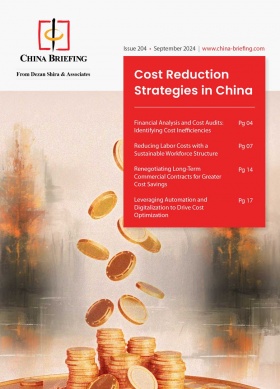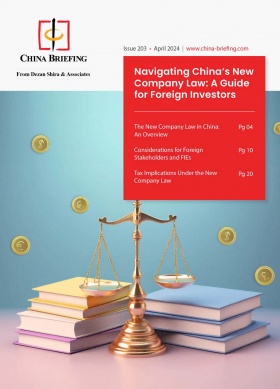23 Matters That Can be Customized in a Company’s Articles of Association (Part II)
The Articles of Association (“AOA”) is the cornerstone document of a company, which sets out critical matters such as the company’s name, registered address, business scope, management system, and other foundational elements. As a written instrument, the AOA defines the basic rules for the company’s organization and operations, serving as a key reference for its governance.
According to the Company Law of the People’s Republic of China (“Company Law”):
A company shall formulate its articles of association pursuant to the law when it is established, which shall be binding on the company, shareholders, directors, supervisors and senior executives.
The AOA represents the collective intention of all shareholders, laying out the fundamental principles for the company’s structure and activities. For this reason, the AOA is often referred to as the “constitution” of the company. It plays a vital role in ensuring the company’s smooth operation, standardizing corporate governance, preventing deadlocks, and safeguarding shareholders’ rights.
In modern corporate law, company autonomy is a core principle, granting shareholders the right to decide on various matters through the AOA. As companies evolve in complexity—encompassing diverse shareholder compositions, governance structures, and personnel—leveraging the legal framework to define key matters in the AOA becomes essential. This allows shareholders to shape governance arrangements that align with their specific objectives.
In this article, we introduce 23 matters that can be freely agreed upon in a company’s AOA in China.
Given the breadth and importance of the topics covered, we will divide this article into three parts for clarity and ease of understanding. Each part will focus on a specific set of matters that can be freely agreed upon in a company’s Articles of Association. This structure will allow readers to delve deeper into the details, ensuring a comprehensive grasp of how to leverage the AOA for effective governance and operational autonomy.
Shareholder voting rights
Legal provisions
Article 65 of the Company Law stipulates that shareholders exercise their voting rights at the shareholders’ meeting according to their shareholding proportion unless otherwise stipulated in the AOA.
Legal analysis
Shareholders’ rights are determined by their shareholding ratio in general. This is one of the basic principles established in the Company Law. Voting is an essential way for shareholders to participate in company decision-making. Adjusting the voting rights proportion can be an important means for minority shareholders to “control” the company, especially for financial investors. For example, minority shareholders may be granted veto rights over certain matters to control the company. This provision gives companies the freedom to establish two key provisions in their AOA: different voting rights for the same share and veto power.
Practical suggestion
The use of this provision should be cautious. It is generally used when shareholders need to relinquish some decision-making powers in exchange for other benefits. The provisions for veto rights should be carefully considered when a major shareholder accepts a financial investor. If veto rights are necessary, it is advisable to limit the scope of the shareholders’ meeting’s authority in the AOA and reduce the number of matters subject to veto to prevent a financial investor from gaining effective control with a small shareholding.
Shareholders’ meeting procedures and voting process
Legal provisions
Article 66 of the Company Law stipulates that the procedures and voting process for shareholders’ meetings, except where provided by law, shall be regulated by the company’s AOA. Resolutions to amend the AOA, increase or decrease registered capital, or decisions on the company’s merger, division, dissolution, or change in corporate structure, must be passed by shareholders representing more than two-thirds of the voting rights.
Legal analysis
This provision requires more than two-thirds of voting rights for certain critical decisions. Other matters can be decided by a simple majority or other majority types as defined in the company’s AOA.
Practical suggestion
To jointly constrain the power of majority shareholders, minority shareholders can include additional matters in the AOA that require approval by more than two-thirds of voting rights. For certain special investors, the AOA may allow decisions to be made based on the number of shareholders or grant veto power over specific matters, as permitted by law. To enhance efficiency and convenience, especially when shareholders are geographically dispersed, the AOA can include provisions for remote meetings through conference calls or video conferencing.
Board of directors’ composition
Legal provisions
Article 68 of the Company Law stipulates that the board of directors of a limited liability company shall consist of three or more members and may include representatives of employees. The board of directors shall have a chairman and may have a vice-chairman. The AOA of the company shall prescribe the method for selecting the chairman and vice-chairman.
Article 69 stipulates that a company may set up an audit committee composed of directors on the board of directors in accordance with the AOA.
Article 75 of the Company Law provides that a limited liability company with a small scale or a small number of shareholders may not have a board of directors but have one director who shall exercise the functions and powers of the board of directors as provided for in this Law. The director may concurrently serve as the manager of the company.
Legal analysis
A limited liability company may choose to establish a board of directors based on its size and the number of shareholders. If a board is established, its composition must include at least three directors, as required by law, with the specific number determined by the company.
The board of directors is typically composed of members recommended by the shareholders’ meeting. In practice, the chairman and vice-chairman may either be appointed directly by the shareholders’ meeting or elected by the board. The chairman plays a pivotal role in the company, often serving as its legal representative and presiding over board meetings. Moreover, the audit committee, when established, contributes significantly to strengthening corporate governance by enhancing oversight, mitigating risks, and ensuring compliance with legal and regulatory requirements.
Practical suggestion
To prevent deadlock in board decisions, it is generally recommended to have an odd number of directors. The appointment of the chairman is a critical factor in the company’s control structure and often becomes a key point of negotiation among shareholders. Since the Company Law does not prescribe the method for selecting or appointing the chairman and vice-chairman, these details should be explicitly outlined in the AOA to avoid potential deadlocks. Additionally, companies with extensive or complex operations should consider establishing an audit committee within the board to bolster governance and risk management practices.
Term for the board of directors
Legal provisions
Article 70 of the Company Law stipulates that the term of office of directors shall be defined in the company’s AOA but shall not exceed three years. directors may be re-elected after their term expires. If the election of directors is not timely conducted, or if a director resigns during their term causing the board member less than the quorum, the original directors must continue to perform their duties until the new directors are appointed.
Legal analysis
The term applies to the board as a collective body, not to individual directors, a distinction that should be carefully considered during replacement or re-election processes. To ensure consistency, it is advisable to synchronize term changes when adding, replacing, or re-electing directors. Although the Company Law mandates that outgoing directors must continue to perform their duties until replacements are appointed, timely replacement is crucial to avoid inefficiencies in board operations.
Practical suggestion
To maintain consistency and stability in the company’s governance, it is advisable to set the directors’ term at the maximum allowable duration of three years. If changes to the board’s structure are necessary, they should be initiated through the shareholders’ meeting. In cases where replacements are delayed, the original directors must fulfill their duties until new directors are appointed. This obligation is legally binding and cannot be overridden or modified by provisions in the AOA.
Powers of the board of directors
Legal provisions
According to Article 67 of the Company Law, the board of directors is accountable to the shareholders’ meeting and is responsible for convening shareholder meetings. The board of directors shall report to the shareholders and perform other duties as stipulated by the AOA.
Legal analysis
The governance structure of a company typically follows a hierarchy:
Shareholders’ Meeting > Board of Directors > Manager
The specific powers of each entity are determined by the Company Law and the company’s AOA. Unlike statutory powers granted by law, the board of directors’ powers must be explicitly defined in the AOA.
Shareholders may expand the board’s authority to improve decision-making efficiency, reflecting their trust in the board. However, restricting the board’s authority showcases shareholders’ cautious control over the company. Modern enterprise practices often favor appropriately expanding the board’s powers, which can enhance business decision-making efficiency and underline the board’s role in corporate development.
Practical suggestion
Shareholders should decide the extent of authority granted to the board of directors based on their desired level of control and the need for efficient decision-making (especially the controlling power exercised by the major shareholders over the board of directors). Minority shareholders should evaluate whether it is advantageous to concentrate authority within the shareholders’ meeting or to expand the board’s powers. As a general principle, any expansion of the board’s authority must be clearly articulated in the AOA. If not specified, the board is limited to statutory powers. Thus, the AOA should provide detailed definitions of the board’s authority to avoid ambiguities.
Board meeting procedures and voting process
Legal provisions
Article 73 of the Company Law stipulates that the procedures and voting process for board meetings, except where provided by law, shall be regulated by the company’s AOA. The Board must record the meeting’s decisions and have all attending directors sign the meeting records. Voting within the board is done on a one-person-one-vote basis.
Legal analysis
While the convenor and presider of board meetings are stipulated by law, other procedural details—such as convenor method, notification requirements, time limit, quorum thresholds, and voting rules, as well as the recording or handling of dissenting opinions—can be defined in the AOA. That said, however, the principle of one-person-one-vote is mandatory and cannot be altered by the AOA.
Practical suggestion
To ensure smooth board operations and minimize disputes, companies should establish clear, actionable procedures in the AOA regarding board meetings and voting. Recording dissenting opinions in meeting minutes is essential, as directors may bear responsibility for decisions that harm the company.
Powers of the manager
Legal provisions
According to Article 74 of the Company Law, a limited liability company may appoint a manager, whose appointment and dismissal are decided by the board of directors. The manager is responsible for the company’s daily operations and the implementation of Board decisions, as well as exercising other powers granted by the board. The company’s AOA may specify additional powers of the manager. The manager shall present at the board meeting but has no voting rights if he/she does not hold the position of the director.
Legal analysis
The manager is in charge of the company’s daily operations and administration, appointed by the board, and is accountable to the board. The manager’s position can be held by a director, an individual shareholder, or a professional manager. The authority of the manager may be delegated by the board of directors, but the authority of such delegation shall not exceed the authority of the board itself. On the other hand, the manager’s authority can also be deprived by the AOA. In short, the power of the manager can be increased or decreased by the AOA. This flexibility distinguishes the manager’s authority from the statutory powers of the board. The statutory power of the board of directors cannot be reduced but be increased by the AOA.
Practical suggestion
The manager plays a crucial role in a company’s daily operations. Nowadays more companies intend to hire professional managers. The company shall carefully consider the authorization and supervision of the manager. Since the functions and powers of the manager can be freely decided by the AOA, the company may independently determine the scope of the manager’s authority according to its actual needs to balance empowerment with accountability.
Powers of the executive director
Legal provisions
Article 75 of the Company Law allows smaller companies or those with fewer shareholders to forgo a board of directors and appoint an executive director instead. The executive director may also serve as the manager and assume the board’s functions.
Legal analysis
When an executive director also serves as the manager, power concentration can be a concern. Unlike the board of directors, whose powers are partly statutory, the executive director’s powers are entirely defined by the AOA. This structure is common in family-owned businesses or companies with few shareholders.
Practical suggestion
To avoid autocracy by the executive director, it is advised that companies with an executive director retain major decision-making powers within the shareholders’ meeting. This helps protect the interests of minority shareholders. Additionally, it is advisable that the roles of executive director and manager be held by different individuals to create checks and balances and provide minority shareholders with opportunities to participate in company operations. The executive director must also fulfill his/her duties diligently to avoid potential liability for damages caused to the company.
About Us
China Briefing is one of five regional Asia Briefing publications, supported by Dezan Shira & Associates. For a complimentary subscription to China Briefing’s content products, please click here.
Dezan Shira & Associates assists foreign investors into China and has done so since 1992 through offices in Beijing, Tianjin, Dalian, Qingdao, Shanghai, Hangzhou, Ningbo, Suzhou, Guangzhou, Haikou, Zhongshan, Shenzhen, and Hong Kong. We also have offices in Vietnam, Indonesia, Singapore, United States, Germany, Italy, India, and Dubai (UAE) and partner firms assisting foreign investors in The Philippines, Malaysia, Thailand, Bangladesh, and Australia. For assistance in China, please contact the firm at china@dezshira.com or visit our website at www.dezshira.com.
- Previous Article 23 Matters That Can be Customized in a Company’s Articles of Association (Part I)
- Next Article 23 Matters That Can be Customized in a Company’s Articles of Association (Part III)







